List of Northeastern U. S. Pilot Boats
This is a list of pilot boats for New York, New Jersey, and Boston, Massachusetts. Some Pilot boats have the same ship number as they may have been replaced with other boats. Ship numbers were used as a Ship identifier.
New York Pilot boats
| Ship No. | Ship Name | Image | Ship Captain | Description |
|---|---|---|---|---|
| No. 1 | Hope (replaced by Herman Oelrichs, No. 1) | 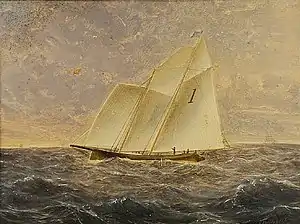 |
Captain Marshall, Thomas Morely | New York pilot-boat Hope, No. 1, was made from a model by Henry Steers in 1862. On 9 October 1873, the Hope was one of the boats that participated in the Ocean Regatta, which was a race from Owl's Head Point around to Cape May Lighthouse in New Jersey, and back to the Sandy hook Lightship.[1] She was lost at Sandy Hook on 15 March 1890.[2] |
| No. 1 | Herman Oelrichs (built to replace the Hope, No. 1) | 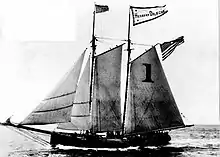 |
Michael Lyons | New York pilot-boat Herman Oelrichs, No. 1, was built in 1894 in Essex, Connecticut, for the New York pilots. She was the "fastest of the New York pilot fleet."[2] She was built to replace the Hope, wrecked in 1890 near Sandy Hook.[3] On 7 June 1910, the pilot-boat Herman Oelrichs, owned by Capt. Fred B. Rice and others, was sold to Captain A. F. Warren, of Pensacola, Florida. She was added to the fleet of fishing schooners owned by the Warren Fishing Company in Florida.[4] |
| No. 2 | Edmund Blunt (replacement for Jacob L. Westervelt No. 19) | 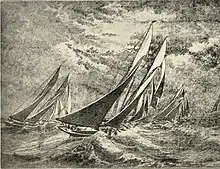 |
Capt. Abram Jones, Josiah Johnson, Jr. | New York pilot-boat Edmund Blunt, No. 2, was launched on 18 August 1858, by E. F. Williams and was owned by New York Pilots.[5] She was built to replace the Jacob L. Westervelt, which was lost by being run down by the Bremen steamer Saxonia on 21 April 1857.[6] On 1 February 1896, the New York Pilots discarded sixteen sailboats and moved them to the Erie Basin in Brooklyn. They were replaced with steam pilot boats. The Edmund Blunt, was sold for $2,000.[7] |
| No. 2 | Edward C. Knight | 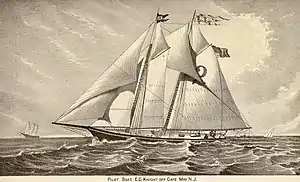 |
Captain Ellis Eldridge | New York pilot-boat Edward C. Knight, was launched from the C. & R. Poillon shipyard at the foot of Bridge Street, Brooklyn, New York on 12 August 1875[8] On 13 February 1895, the pilot boat E. C. Knight off Cape May, New Jersey went missing for several days but was found.[9] On 11 September 1898, the pilot boat E. C. Knight was sold to the Brunswick Pilots' Association of Georgia for $2,800 by her current owners Pilots' Association for Delaware.[10] |
| No. 3 | Charles H. Marshall | 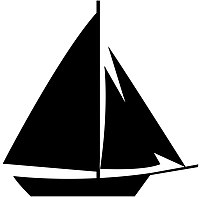 |
John L. Calvin Sr., Frederick Nelson | New York pilot-boat Charles H. Marshall, No. 3, was built by Henry Steers (1832) for Captain J. Johnson, A. Nelson and other New York and Sandy Hook pilots. On June 20, 1860, she was launched from the foot of twelfth street, East River.[11] She made a trail trip on 9 July 1860, and went to the Sandy Hook Lightship and back.[12] The Charles H. Marshall was one of twenty-one New York pilot boats in 1860.[13] In the Great Blizzard of 1888, boat-keeper Robinson, of the Charles H. Marshall, No. 3, provided a day-by-day report.[14] On 1 February 1896, the New York Pilots discarded sixteen sailboats and replaced with steam pilot boats.[7] |
| No. 4 (also listed as No. 22) | Washington | 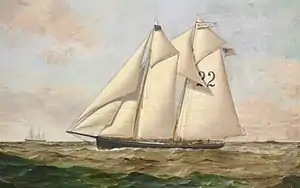 |
T. Murray; or M. Murphy | The Washington, No. 4, was a 19th-century New York City pilot boat built in 1845. She one of the twenty-one New York pilot-boats sailing in 1860.[13] This boat is listed in the Record of American and Foreign Shipping from 1876 to 1886 with the owners as the N. Y. Pilots and Captain Thomas Murray as master.[15] Pilot John Van Dusen was one of the pilots on the Washington, No. 4.[16] The pilot boat Washington, used No. 22 as a boat number from 1868 to 1884. On August 2, 1884, the German steamship Roma, ran down the pilot-boat Washington, No. 22.[17] |
| No. 4 | Abraham Leggett (replaced by Alexander M. Lawrence, No. 4) | 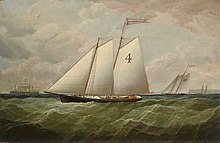 |
Michael Murphy | New York pilot-boat Abraham Leggett, was 82 foot in length, 55.18-tons, built in 1870 by D. Westervelt. Michael Murphy was the captain.[18] On 3 Feb 1879, the Abraham Leggett was sunk by the steamship Naples.[19]:p20[20] The Alexander M. Lawrence, No. 4, was built to take the place of the old Abraham Leggett, No. 4.[21] |
| No. 4 | David Carll | (picture in "Pilots" book) | New York pilot-boat David Carll, was built in 1876 at City Island, New York. She was 125-tons. She was a pilot schooner. The painting is by Conrad Freitag. She has the No. 4 on her mainsail with the pennant flag with her name on it. On March 25, 1873, it was announced that Mr. David Carll, of City Island, was building a sloop yacht for parties in New Jersey. She 44 feet keel, 16 feet 8 inches beam and 5 feet depth of hold. He has a shipyard at City Island.Yachting Notes. | |
| No. 4 | Alexander M. Lawrence (replaced the Abraham Leggett) | 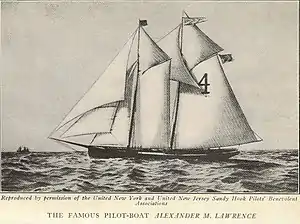 |
N. Y. Pilots, Michael Murphy, H. B. Cogswell | New York pilot-boat Alexander M. Lawrence, No. 4, was a station boat. She was one of the largest and best in the Sandy Hook fleet.[13] The Lawrence was one of the representative pilot boats of the fleet and her pilot-boat model was exhibited by the Pilot Commission of New York at the 1893 Chicago World's Fair along with oil paintings illustrating the perils of the service.[22] The Alexander M. Lawrence, No. 4, replaced the Abraham Leggett, No. 4.[21] |
| No. 4 | Jacob Bell | (no picture) | John T. Smith | In 1840, the pilot boat, Jacob Bell was built by Brown & Bell shipyard at New York City. She was launched on 22 Jan 1840 and was named in honor of the shipbuilder Jacob Bell, a partner in the firm. In 1840, she was one of only eight New York pilot boats.[23] New York Sandy Hook pilot-boat Jacob Bell, No. 4, went ashore in a gale on Sandy Hook in April 1854. She was able to return to the city.[19][24] See also Jacob Bell, a sidewheel steamer, built by Brown & Bell at New York City in 1842. |
| No. 5 | Mary Taylor (Replaced by Mary E. Fish, No. 4) |  |
Richard Brown | New York pilot boat Mary Taylor, built in 1849 at Williamsburg, New York and designed by George Steers for Captain Richard Brown. Brown named her after the scandalous actress Mary Taylor. Steers designed her with a new thin bow and wide stern, which made her faster than any boat of her size.Museum Exhibition Commemorates Yacht Races For America's Cup. The Mary Taylor was followed the next year by the Moses H. Grinnell, which led to the famous yacht America. On November 10, 1863, the Mary Taylor was lost by a three-masted schooner Fair Haven, near Barnegat, New Jersey.[19]:p23 |
| No. 5 | David Mitchell | (no picture) | Thomas Dexter, Alex Cocshran (1860) | The new pilot-boat David Mitchell, was from Baltimore, Maryland and arrived in Norfolk, New York on 2 October 1846.[25] The David Mitchell, No. 5, was one of only twenty-one New York and New Jersey pilot boats in 1860.[13] In 1874, the D. Mitchell, No. 3, was listed with the New Jersey Pilots and Thomas Dexter as her captain.[26] The D. Mitchell, was listed as a Pilot Schooner with the Record of American and Foreign Shipping from 1876 to 1881. Captain Thomas Murray was the ship master.[27] |
| No. 5 | Charlotte Webb (James Funk, No. 22, came before her) | (no picture) | Edward Fryer, A. C. Malcolm (1885) | New York pilot-boat Charlotte Webb, was owned by the N. Y. Pilots' Association. On May 25, 1865, the Brooklyn Union reported that a new pilot-boat, the Charlotte Webb, was on the stocks at the Webb and Bell shipyard in Greenpoint, Brooklyn, to take the place of the James Funk, No. 22, that was destroyed by the rebel CSS Tallahassee.[28] On May 19, 1889, the Charlotte Webb was run down by the French steamer La Normandie in a dense fog eight miles east of Sandy Hook. Two pilots on the Charlotte Webb, were lost in the accident.[29] |
| No. 5 | David T. Leahy (renamed James Gordon Bennett and listed as New Jersey pilot boat) | (no picture) | James D. M. Beebe, Captain Dennis Reardon | New York pilot-boat David T. Leahy, was launched on 3 September 1890 from the C. & R. Poillon shipyard at the foot of Clinton Street. Lulu Cooper, daughter of Pilot John Cooper, broke the champagne bottle on the bow. Captain James D. M. Beebe was part-owner of the boat.[30] On October 1, 1890, the David T. Leahy went on her trail trip. She was pulled out from her moorings at the foot of Peck slip, New York, by a tugboat Adelaide.[31] On June 16, 1893, the New York pilot-boat David T. Leahy, No. 5, collided in a thick fog, with the Royal Phelps Carroll's Yacht Navahoe, 250 miles off Sandy Hook.[32] |
| No. 6 | Blossom | (no picture) | James Mitchell[33] | The pilot boat, Blossom was reported off Sandy Hook as early as 1837.[34] On 21 August 1839, the Amistad was discovered thirty miles southeast of Sandy Hook. The pilot-boat Blossom came across the vessel and supplied the men with water and bread. When they attempted the board the pilot-boat to escape, she cut the rope that was attached to the Amistad. The pilots then communicated what they felt was a Slave ship to the Collector of the Port of New York.[35][36] In 1840, there were only eight New York pilot boats. They were the Phantom, No. 1; Washington, No. 2; New York No. 3; Jacob Bell, No. 4; Blossom, No. 5; T. H. Smith, No. 6; John E. Davidson, No. 7; and the Virginia, No. 8.[23] |
| No. 6 | James Gordon Bennett (formerly known as David T. Leahy and listed as New Jersey pilot boat) | (no picture) | D. C. Chapman | New York pilot-boat James Gordon Bennett was built in 1870 by Lawrence & Foulkes.[26] Designed by William Townsend.[37] On 14 Jan 1893, the pilot-boat James Gordon Bennett went ashore with her masts gone and part of her deck.A Pilotboat Breaking Up. On 7 Aug 1893, a new pilot boat James Gordon Bennett was launched at the Poillons shipyard, foot of Clinton Street. She was now part of the New York pilot fleet.Launch Of A New Pilot Boat. On August 18, 1901, the pilot-boat James Gordon Bennett, formerly known as the David T. Leahy, sank off Sandy Hook when the German Atlas Line steamship Alene hit the Bennett on a clear day.[38] |
| No. 6 | George Steers (replaced by A. T. Stewart, No. 6) | New Jersey Pilots | The George Steers was a 19th-century pilot boat built in 1852 for the New Jersey Pilots' Association. She was designed by the yacht designer George Steers and considered to be one of the fastest boat sailing. She had a popular shorter bow overhang, similar to the celebrated yacht America.[2] The pilot-boat A. T. Stewart replaced her when the Steers was lost in February 1865, at Barnegat Island. All her crew perished from the cold. | |
| No. 6 | A. T. Stewart (replaced George Steers, No. 6) | (no picture) | New Jersey Pilots | The A. T. Stewart was a 19th-century pilot boat, that was launched on 11 October 1865, from the shipyard of E. F. Williams, at Greenpoint, at a cost of $21,000, to replace the George Steers, No. 6, which was lost in February 1865.[39] When the A. T. Stewart, was lost in 1869, the James Gordon Bennett, No. 6 was built in 1870 to replace her.[40] |
| No. 6 | Mary and Catherine (replaced by the William H. Starbuck) | (no picture) | Jacob M. Heath (owner) | New York pilot-boat Mary and Catherine, No. 6, was one of twenty-one New York pilot boats in 1860 built by Aaron Westervelt.[13] This boat is listed in the Index to Ship Registers with the owners as the N. Y. Pilots.[41] She went down and sank on 8 November 1885 by a tramp steamer Haverton off Absecon Lighthouse.[19]:p23 Pilot Oscar Stoffenden was in charge of the boat. Owners said they would build another boat.[42] Other pilots were: Oscar Stoffenden (pilot), Frederick Reinsen (owner), John J. Devere (pilot), Van Pelt (pilot), John Taylor[26] |
| No. 6 | William H. Starbuck (took the place of the Mary and Catharine) | _(14759219626).jpg.webp) |
Jacob M. Heath, Oscar Stoffenden, Frederick Riersen | New York pilot-boat William H. Starbuck, No. 6, was run down by the SS Japanese off Barnegat, New Jersey on 12 March 1888, with six men on board.[19][42] On 1 February 1896, the New York Pilots discarded sixteen sailboats and moved them to the Erie Basin in Brooklyn. They were replaced with steam pilot boats. |
| No. 6 | Thomas H. Smith | 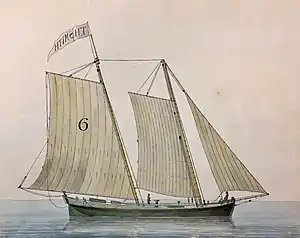 |
Owen Callanan | The pilot boat, T. H. Smith was reported off Sandy Hook as early as 1824.[43] In 1840, she was one of only eight New York pilot boats.[23] In 1857, she was lost when she went ashore.[44] |
| No. 6 | Joseph N. Lord |  |
unknown | Reports of the pilot-boat Joseph N. Lord, begin in 1840 for the New York newspapers. There are no reports after 1845. There is a picture of the Joseph N. Lord with the and No. 6 on her mainsail and a pennant flag with her name on it. |
| No. 7 | Sarah Frances | (no picture) | unknown | New York pilot-boat Sarah Frances, went down with all on board in 1853.[24] |
| No. 7 | Elwood Walter | 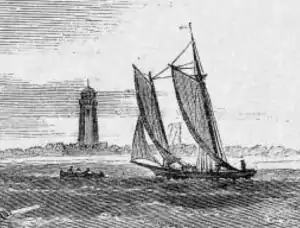 |
Joseph Henderson | New York pilot-boat Elwood Walter, No. 7, was built by Edward F. Williams of Greenpoint, Brooklyn, New York in 1853. The schooner was named after Ellwood Walter (businessman), the President of the Mercantile Mutual Insurance Company. She was one of twenty-one New York pilot boats in 1860.[13] Other pilots were: William J. Murphy, Augustus H. Murphy, Charles W. Hawthorne, Thomas Orr. |
| No. 7 | Edmund Driggs | 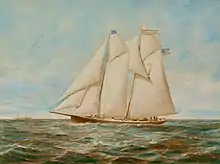 |
Captain William M. Qualey, A. Bourne | New York pilot-boat Edmund Driggs No. 7, (41.68-tons) was built by E. F. Williams. She was cast ashore in the blizzard of 1888 but survived.[13] On 27 July 1894, she boarded the French man-of-war Huzzard outside the bar.[45] On 1 February 1896, the New York Pilots discarded sixteen sailboats and moved them to the Erie Basin in Brooklyn. They were replaced with steam pilot boats. The Edmund Driggs, was sold for $3,500.[7] |
| No. 7 | Hermit | (no picture) | Pilots McCarthy, Nielsen, and Warvey | New York pilot-boat Hermit, No. 7. She was sunk and split into two, by the Ward Line steamer Monterey by accident in thick weather, near the Sandy Hook Lightship. The crew escaped without any loss of life.[46] |
| No. 7 | John E. Davidson | (no picture) | Henry J. Bullinger | The pilot boat, John E. Davidson was reported as early as 1839.[47] In 1840, there were only eight New York pilot boats. They were the Phantom, No. 1; Washington, No. 2; New York, No. 3; Jacob Bell, No. 4; Blossom, No. 5; T. H. Smith, No. 6; John E. Davidson, No. 7; and the Virginia, No. 8.[23] On 14 December 1840, Chas. D. Ludlow, of the pilot boat John E. Davidson, along with other pilots from the port of New York, stated that they had never been employed by J. D. Stevenson and no compensation has been offered or demanded.[33] |
| No. 8 | Richard K. Fox | 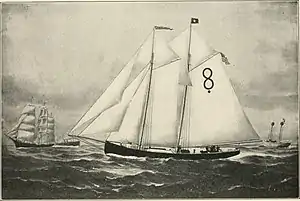 |
Chas. H. Harty | Boston pilot-boat Lillie, No. 1, was 47.68-tons, built at East Boston, Massachusetts, on a model by Dennison J. Lawlor in 1876. She was later sold to the New York pilots and renamed the Richard K. Fox.[48] On 1 February 1896, the New York Pilots discarded sixteen sailboats and moved them to the Erie Basin in Brooklyn. They were replaced with steam pilot boats. The Richard K. Fox, was sold for $4,000.[7] |
| No. 8 | Isaac Webb (replaced by Columbia in 1878) | 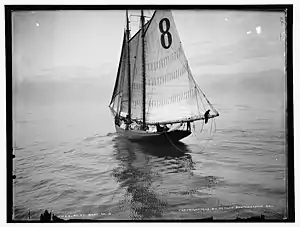 |
Augustus Van Pelt | New York pilot-boat Isaac Webb No. 8, (49.91-tons) was built by Webb & Bell shipyard for the New York and Sandy Hook pilots on 31 October 1850. In late July 1879, the Webb was stuck on Quonochontaug Beach, Long Island. She was shipwrecked and became a total loss.[13][49] Augustus Van Pelt was the captain.[26] |
| No. 8 | Virginia | (no picture) | Captain Wright | The pilot boat, Virginia came from Savannah to New York City, on 24 April 1838. Captain G. Wright was in command.[50][51] In 1840, there were only eight New York pilot boats. They were the Phantom, No. 1; Washington, No. 2; New York, No. 3; Jacob Bell, No. 4; Blossom, No. 5; T. H. Smith, No. 6; John E. Davidson, No. 7; and the Virginia, No. 8.[23] On 14 December 1840, This. E. B. Johnson, of the pilot boat Virginia, along with other pilots from the port of New York, stated that they had never been employed by J. D. Stevenson and no compensation has been offered or demanded.[33] On 14 August 1843, Captain Wright, of pilot boat Virginia, which was 45 miles east of Cape Henlopen, spoke to brig Wm. Neilson, from New York bound to Port-au-Prince.<ef>Marine List. The Evening Post (New York, New York), 14 Aug 1843, Page 1</ref> On 17 July 1848, the New York pilot boat Virginia, spoke to the British Brig Sisters, that the brig was short of provisions. She was on her way to Halifax, Nova Scotia.[52] On 26 October 1850, the pilot boat Virginia, near the Narrows, was run into by the an unknown schooner.[53] Starting in 1854, the pilot boat Virginia was called the Virginia No. 3. On 13, Oct 1854, she came acorss a feamale figurehead of a vessel.[54] |
| No. 9 | James Avery | (no picture) | David S. Nicolay, John Henderson[33] | New York pilot-boat James Avery, No. 9 was launched on 9 Sep 1837 from the Brown & Bell shipyard near Dry Dock. Family and friends were present for the occasion. She was 33-tons.[55] In 1860, she was one of only twenty-one New York and New Jersey pilot boats in the fleet.[13] David S. Nicolay served as boat-keeper on the James Avery No. 9, from 1866 to 1867. The pilot boat James Avery, No. 9, was last reported on June 16, 1872, having spoke to Schoolship Mercury, 12 miles off the Highlands.Spoken. |
| No. 9 | Pet | 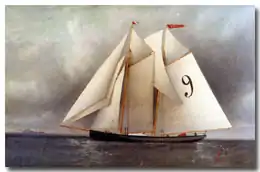 |
Joseph Henderson, Abel F. Hayden | Pilot-boat Pet was built in 1866 by Edward E. "Ned" Costigan at Charlestown, Boston, Massachusetts, for Pilot Captain Abel F. Hayden. She was 54 tons and steered by a tiller. She was in service for a number of years in Boston and later sold to the New York pilots.[56] On 29 August 1872, Captain Joseph Henderson (pilot) purchased the Boston pilot-boat Pet.[57] |
| No. 10 | Jesse Carll | 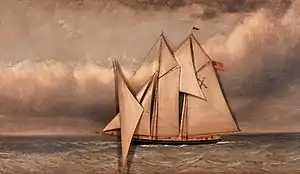 |
W. H. Anderson | New York pilot-boat Jesse Carll, No. 10 was built at Northport, New York in 1885. The pilot boat was named after the shipbuilder, Jesse Carll.[58] Her length on water line, 90 ft.; beam, 23 ft. 3; depth, 8 ft. 6; (rigging steel), one year old; draft, 10 ft. 5.[41] On 1 February 1896, the New York Pilots discarded sixteen sailboats and moved them to the Erie Basin in Brooklyn. They were replaced with steam pilot boats. The Jesse Carll, was sold for $5,500.[7] |
| No. 10 | James M. Waterbury | 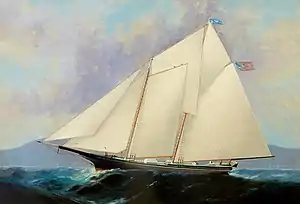 |
Thomas Morely | New York pilot-boat James M. Waterbury, No. 10 or J. M. Waterbury, was one of twenty-one New York pilot boats in 1860.[13] The Waterbury was registered with the Index to Ship Registers from George Brooks 1871–1873 to Captain Thomas Morely. She was built in 1843 and was 76-tons[41] |
| No. 10 | Widgeon (John D. Jones was replaced by the Widgeon) | 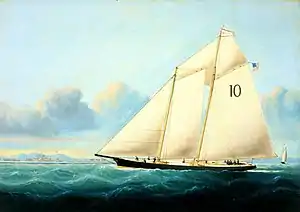 |
Franklin Osgood, P. R. Baillie[26] | New York pilot two-masted schooner Widgeon was originally built as a yacht for owner Franklin Osgood of the New York Yacht Club by designer by George Steers in 1855.[41] On April 30, 1871, the schooner Widgeon, formerly owned C.C. Dodge and G.G. Haven, was sold to the New York pilots of the boat John D. Jones, that sank in a collision with the steamer City of Washington.[59] |
| No. 11 | Edward K. Collins or E. K. Collins | (no picture) | Robert B. Mitchell, James R. Murphy | New York pilot-boat Edward K. Collins, or E. K. Collins, No. 11 was built in the early 1840s. An early report of the E. K. Collins appeared in the New York Daily Herald on 20 December 1844, which talked about the Collins taking a 3-day cruise and coming to port for provisions.[60] She was 89-tons burthen and owned by Wm. P. Tornure, John L. Tornure, James H. Tornure, Eugene H. Sullivan and James R. Murphy. On 6 February 1845, the Collins, while on pilot duty, went ashore at Gowanus Bay because of gale and ice. The next day, she was able to come into New York City.[61] On February 1, 1848, near Sandy Hook, two pilots, Robert Smith and Andrew Foster lost their lives attempting to board from the pilot-boat E. K. Collins to the brig Robert Bruce.[62] On 10 January 1856, the Collins ran ashore on the Fire Island bar in a blinding snow storm. Four of the crew were frozen to death, including pilot Robert B. Mitchell. Others escaped in one yawl on board. She was valued at $4,500.[19][24][63] The cabin boy, James Rush, was on the boat for thirty-two hours before he was picked up by a life-boat.[64] See Edward Knight Collins for information on the boat's namesake. |
| No. 11 | George W. Blunt |  |
Joseph Henderson, James Callahan, John Phelan (2nd Blunt) |
New York pilot-boat George W. Blunt, No. 11 was one of twenty-one New York pilot boats in 1860.[13] She was built by Daniel Westervelt, son of Jacob Aaron Westervelt of the shipyard Westervelt & Co., in 1856. She was acquired by the Union Navy in 1861 and commissioned as USS G W Blunt.[65] She was used by the Union Navy during the American Civil War as a gunboat as well as a dispatch boat in support of the blockade of Confederate waterways until decommissioned and sold in 1865.[66] A second George W. Blunt (52-tons) was built in Boston in 1861 by Brown & Lovell for the New York pilots to take the place of the original George W. Blunt.[65] |
| No. 11 | Phantom | _(14759218506).jpg.webp) |
R. Yates, John Handran | New York pilot-boat Phantom, No. 11, was a 95-ton pilot boat, designed by Dennison J. Lawlor and owned by James Berger, George Berger, and J. J. Bennet of New York City. She was built in Smithtown, New York, and valued at $4,000.[67] The SS Oregon was rescued by the pilot boat Phantom No. 11.[19] During the blizzard of March 1888, the Phantom No. 11 were lost with all hands.[24] |
| No. 11 | William H. Bateman |  |
John Handran | New York pilot boat William H. Bateman, Mary A. Williams, and Edmund Blunt raced and competed for honors in May 1890. Pilot John Handran was lost on pilot-boat Bateman No. 11 that was lost, on 15 April 1889.[19][68] |
| No. 12 | William J. Lord | 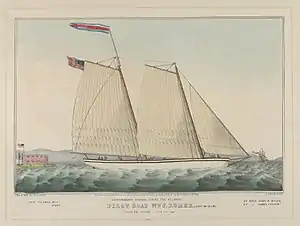 |
James McGuire; George H. Sisco (1860) | New York pilot-boat, William J. Romer, No. 12, was one of twenty-one New York pilot boats in 1860.[13] Captain James McGuire was on the Romer when she left for England on 9 February 1846.[19] The Wm. J. Romer (no. 12) was sold to go to Texas, to be used as a pilot-boat at the port of Galveston.[69] |
| No. 12 | Ariel Patterson | 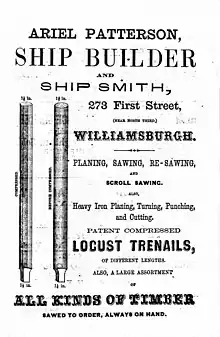 |
J. W. Stanton | New York pilot-boat Ariel Patterson, No. 12, was launched on 23 November 1864 by Ariel Patterson at his shipyard at the foot of North Third Street, Brooklyn, New York.[26][70] The pilot-boat Christianberg, No. 16, was piloted by Camille Lavand and Captain Jacob Britton (Christianberg, No. 15). She was registered with Record of American and Foreign Shipping, from 1879 to 1885, with the N. Y. Pilots as owners and J. W. Stanton, as ship Master.[71] On March 5, 1883, the pilot-boat Ariel Patterson, No. 12, was run down and sank off Seabright, New Jersey, by the steamer Commonwealth. Pilot John Campbell, of Staten Island, went down with the ship.[72] She was raised and purchased by the Coast Wreking Company. The Patterson was formerly named the Christianberg, and was the oldest pilot-boat in the service.[73] |
| No. 12 | Ambrose Snow |  |
Pilot Charles Alkens, William Murphy | New York Pilot-boat Ambrose Snow, was launched on July 3, 1888 from the C. & R. Poillon shipyard, at the foot of Clinton Street. The daughter of P. McEnaney broke the champagne bottle over her bow. Her name is in honor of Ambrose Snow, the president of the New York Board of Pilots. The launch was witnessed by the owners, P. McEnaney and others in the company of New York pilots, along with friends and Captain Ambrose Snow. Pilot Charles Alkens and two sailors boarded the Nova Scotia bark Latonie off Block Island in a yawl.Staten Island.[19]:p40 On 24 May 1912, the pilot-boat Ambrose Snow, No. 2, sank after being struck by the Clyde line freighter Delaware. No lives were lost.[74] |
| No. 13 | Caldwell H. Colt | 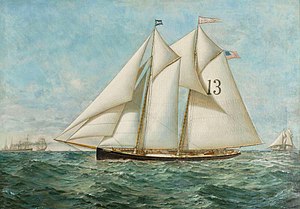 |
Captain Thomas Dougherty | New York pilot-boat Caldwell H. Colt, No. 13, was launched on September 13, 1887 from the Samuel H. Pine's shipyard on Kent Street in Greenpoint, Brooklyn. She has 13 letters in her name, was launched on the 13th, and had 13 members of The Thirteen Club on board during her launch. She had 13 berths in her hold and a crew of 13 men. Elizabeth Colt Beach, age 13, christened the boat.[75] The pilot-boat displayed the number "13" on her mainsail. Captain Thomas Dougherty was one of her pilots.[76] |
| No. 13 | Mary Ann | (no picture) | John Cannon (1860) | New York pilot boat Mary Ann, No. 13 was one of twenty-one New York pilot boats in 1860. Several reports about the Mary Ann, No. 13 going ashore outside of Sandy Hook.[77] On October, 10, 1860, New York Sandy Hook Pilot John Cannon, of the pilot boat Mary Ann, No. 13, signed a statement along with other pilots, that they were satisfied with the representation they have received from the New York Board of Commissioners of Pilots.[78] |
| No. 13 | Francis Perkins | 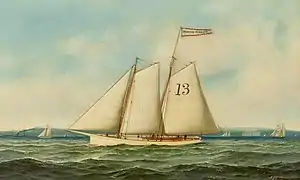 |
unknown | New York pilot boat Francis Perkins No. 13, (52.44-ton) was built by Henry Steers (1832) in 1866 in Greenpoint, Brooklyn.[41] Hailing from New York, she was struck by a wreck on Barnegat shoals in a gale and snow storm on January 24, 1887.[79][24] Pilot Robert Vineer and William Dalton were lost when the Francis Perkins sank.[80][24] Pilot Walter A. Reddin, was one of the two men who was lost from Pilot-boat No. 13, when she ran ashore.[81] |
| No. 14 | Edwin Forrest | (no picture) | John Jeffries, Henry Harbinson | New York pilot-boat Edwin Forest No. 14, was built by Jacob A. Westervelt's Sons & Co.. She was launched on 27 March 1855 from the Westervelt shipyard at the foot of Houston Street for a company of New York and Sandy Hook pilots. She was named in honor of the great American Shakespearean actor, Edwin Forrest.[82] On 2 April 1855, a trial trip of the Pilot-Boat Edwin Forrest was made from the Battery and proceeded down the bay as far as the Lightship.[83] The Edwin Forest No. 14, was one of twenty-one New York pilot boats in 1860.[13] |
| No. 14 | Edward F. Williams |  |
George H. Berry | New York pilot-boat Edward F. Williams No. 14 was 52.86-tons was built by E. F. Williams in New York. In the March blizzard of 1888, Pilot Boat Edward F. Williams No. 14 dragged her anchors and went ashore in the Sandy Hook horseshoe.[13] On 1 February 1896, the New York Pilots discarded sixteen sailboats and moved them to the Erie Basin in Brooklyn. They were replaced with steam pilot boats. The Edward F. Williams, was sold for $4,000.[7] |
| No. 15 | Actaea or Actea | (no picture) | Pilot Keeley | New York pilot-boat Actaea, No. 15 was built in 1880; length, 94 ft. 9; beam, 22 ft. 1; depth, 9 ft. 1; thoroughly overhauled in 1891. She came into port with the steamer Caledonia with a school of whales.[84] On 1 February 1896, the New York Pilots discarded sixteen sailboats and moved them to the Erie Basin in Brooklyn. They were replaced with steam pilot boats. The Actaea, was sold for $4,500.[7] |
| No. 15 | John D. Jones (replaced by Widgeon, No. 10) | 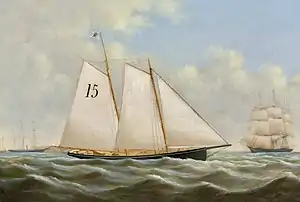 |
Theodore Robinson; Frederick Baudier (1860) | New York pilot-boat John D. Jones, No. 15, was 125-tons, and one of twenty-one New York pilot boats in 1860. On 18 March 1871, pilot boat J. D. Jones, while in the act of boarding the Inman Line steamship City of Washington, from Liverpool for New York, 280 miles east from Sandy Hook, was run into and struck sinking her in 15 minutes in a stormy night. The pilots and crew all saved.[85] |
| No. 15 | Caprice | 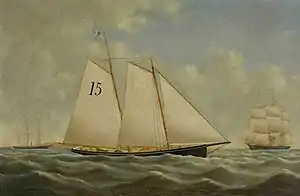 |
Captain Dearborn, E. H. Sullivan, Geo. H. Sisco | Pilot-boat Caprice, No. 15, was built in 1871 by Brown & Lovell at East Boston for McEnany and other Sandy Hook pilots in New York. She was launched as a clipper yacht from the shipyard Brown & Lovell.[86] She was sunk by the steamship New Orleans, belonging to the Cromwell line. No lives were lost. Captain Derborn was found in his cabin in the rear of the pilot house.[87][26] She was registered with the Record of American and Foreign Shipping from 1874 to 1885 her ship master was Geo. H. Sisco; her owners were Eugene Sullivan & Peter McEnry, and she belonged to the port was New York.[88] |
| No. 16 | Christian Bergh |  |
E. Comfort, Jacob Britton (1860) | New York pilot-boat Christian Bergh, No. 16 was built by Aaron Westervelt of New York.[89] She was one of twenty-one New York pilot boats in 1860. |
| No. 16 | Joseph F. Loubat or L. F. Loubat | 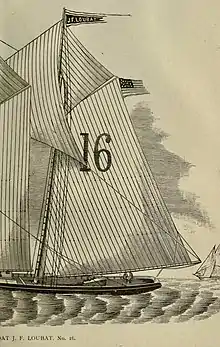 |
Electus Comfort and Frank P. Van Pelt | New York pilot boat Joseph F. Loubat, No. 16 was a Sandy Hook New York pilot boat. She was built for Captain Electus Comfort, W. J. Barry, James McCarthy, and Maurice J. Mariga. The steamer Santiago sank the Loubat pilot boat. Captain Frank P. Van Pelt was rescued.[19] She was built by Jacob S. Ellis at an expense o $13,000. The name of the boat was chosen as Joseph F. Loubat who was a yachtsman. She was launched at Jacob S. Ellis's shipyard in Tottenville, Staten Island, on Saturday, 18 December 1880.[1] On 1 February 1896, the New York Pilots discarded sixteen sailboats and replaced with steam pilot boats. The Joseph F. Loubat, was sold for $4,000.[7] |
| No. 17 | Fannie |  |
Captain John Martin, C. H. Wolsey[26] | New York pilot boat Fannie, No. 17 (51.30-tons) was one of twenty-one New York pilot boats in 1860 built by E. F. Williams.[13] There are several newspaper accounts of doing business as a New York pilot boat from 1860 through 1891. On 1 February 1896, the New York Pilots discarded sixteen sailboats and moved them to the Erie Basin in Brooklyn. They were replaced with steam pilot boats. The Fannie, was sold for $4,000.[7] |
| No. 18 | Enchantress |  |
Daniel V. Jones, T. H. Metcalfe[26] | New York pilot boat Enchantress No. 18, was one of the oldest boats in the service and one of twenty-one New York pilot boats in 1860. She was built by Daniel Westervelt of New York.[13] On 1 April 1884, the Enchantress went adrift when it hit the schooner Sarah and Lucy. The crew of the pilot boat consisted of six men. Pilots Martineau and Frank Van Pelt, jumped into the water and were picked up by the crew of the schooner.[90] She went down with all hands on 13 March 1888, blizzard. Pilot Daniel V. Jones and others were lost.[19] |
| No. 18 | James Stafford | 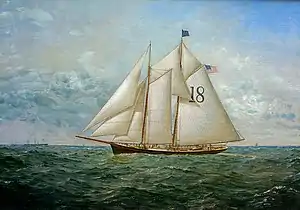 |
Pilot C. Peterson | New York Pilot boat James Stafford, No. 18 was built on 4 November 1888. On 13 February 1895, Pilot-bat Stafford, No. 18, which had been missing at sea for several days, arrived at Stapleton, Staten Island, this morning in tow by a tug. Pilot Peterson had the Stafford in charge.[26] On 1 February 1896, the New York Pilots discarded sixteen sailboats and moved them to the Erie Basin in Brooklyn. They were replaced with steam pilot boats. The James Stafford, was sold for $5,500.[7] |
| No. 19 | Mary A. Williams |  |
H. Burnett | New York pilot boat Mary A. Williams, was built in 1861 for the New York and Sandy Hook pilots. She was launched on January 28, 1861, from the E. F. Williams shipyard, at Greenpoint, Brooklyn.[91] The Mary A. Williams, No. 19, was one of only twenty-one New York pilot boats existing 1860.[13] The New York pilot boat Mary A. Williams was rebuilt in 1892 from the keel up. She was rebuilt at the Poillon shipyard from stem to stern. On 1 February 1896, the New York Pilots discarded sixteen sailboats and they were replaced with steam pilot boats. The Mary A. Williams, was sold for $5,500.[7] |
| No. 19 | Jacob A. Westervelt (replaced by Edmund Blunt) | 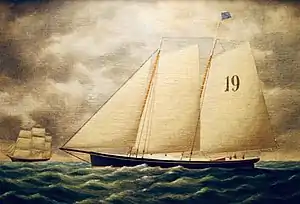 |
John O’Keefe | New York pilot-boat Jacob A. Westervelt, No. 19 was built in 1853 by Aaron J. Westervelt. She was 110 tons burthen and one of the best and fastest boats in the fleet.[92] She was run down and sunk by the British steamer Saxonia on Tuesday morning, 20 April 1858. Her captain, John O’Keefe, drowned. The Pilots' Association via the Sandy Hook Pilots' Charitable Fund, awarded Mrs. O'Keefe a pension of $8.00 per month for each child until they were 13 years old.[93] |
| No. 20 | Nettle | 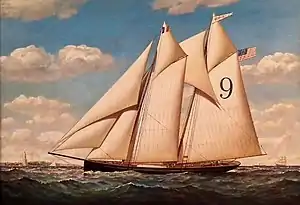 |
Wm. C. Wood (1860) | Pilot-boat Nettle, No. 20, was built by S. Hall of East Boston, Massachusetts in 1844. The Boston Merchant's Exchange put her up for sale in 1845.[94] The Nettle was registered with the Record of American and Foreign Shipping, from 1871 to 1879, as a Pilot Schooner, with E. C. Mosser as owner and Pilots F. Willis and Johnson as the Masters. By 1879, she belonged to the Pensacola port.[95] She was one of only twenty-one New York pilot boats in 1860 in the New York pilot-boat fleet.[96] On February 28, 1876, the wreck of the pilot-boat Nettle was reported lying 1 mile from the outer bar buoy in 4 1/2 fathoms of water.Notice to Mariners., The Boston Globe (Boston, Massachusetts), 28 Feb 1876, Page 7. |
| No. 20 | Edward Cooper (Joseph Pulitzer was replacement for Edward Cooper) | 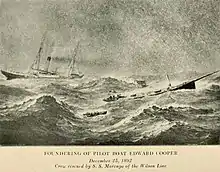 |
Captain Heath | New York pilot-boat Edward Cooper was built in 1879 for New York Pilots at Greenpoint, Brooklyn. Captain Heath was master of the boat from 1884 to 1892.[41] Pilot James Smith was drowned while boarding the steamer Van Dyk from the pilot-boat Edward Cooper, No. 20 on February 27, 1892.[19] Joseph Pulitzer was a replacement for the Edward Cooper. |
| No. 20 | Joseph Pulitzer (replacement for Edward Cooper, No. 20) | 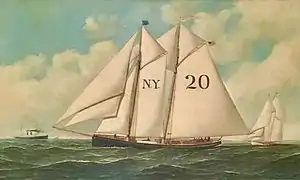 |
Captain J. M. Heath | New York pilot-boat Joseph Pulitzer was built in 1894 at Essex, Massachusetts for the New York Captain J. M. Heath.[2] She was a replacement for the Pilot Boat Edward Cooper, No. 20, that sank off Sandy Hook in December 1892. She rescued part of the crew and some of the passengers of the schooner Georgiana Young, who had abandoned their ship after it had stranded in an easterly gale, on Roamer Shoal.[19] On 1 February 1896, the New York Pilots discarded sixteen sailboats and replaced with steam pilot boats.[7] See Joseph Pulitzer, the famous newspaperman. In January 1898, Captain Cordiner brought the Joseph Pulitzer, recently purchased by the Oregon Pilots Association, around the Horn to Astoria, Oregon. In 1909 the Port of Portland decided to purchase the Joseph Pulitzer from the Columbia River bar pilots for $10,000. |
| No. 21 | William H. Aspinwall | 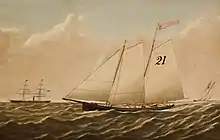 |
Capt. Walter Brewer[26] | New York pilot boat William H. Aspinwall, No. 21 was launched on 30 January 1861, from the yard of J. B. Van Dusen Bros at East River. Her owners were Mrs. Dale, Henry L. Weaver, John Shooks, and James Callahan.[97] On 21 April 1880, the William H. Aspinwall, No. 21 was lost near Fire Island in April 1880. Captain Walter Brewer commanded the lost boat and was part owner.[98] On 5 January 1881, a new pilot boat, the America was substituted for the William H. Aspinwall, No. 21, which was lost off Point Judith.[99] |
| No. 21 | America | 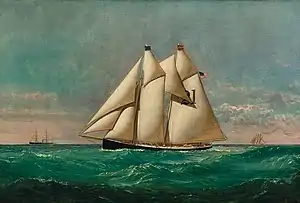 |
Joseph Henderson, James Jackson; Edward Develin; Walter Brewer; A. H. Murphy, Jr. | New York pilot-boat, the America was substituted for the William H. Aspinwall, No. 21, which was lost off Point Judith on 5 January 1881.[99] America was registered from 1882 to 1900 for N.Y. Pilots, and master Walter Brewer.[100] On 1 February 1896, the New York Pilots discarded sixteen sailboats and moved them to the Erie Basin in Brooklyn. They were replaced with steam pilot boats. The America, was sold for $5,500.[7] |
| No. 21 | Anthony B. Neilson (came before John D. Jones, No. 15) |  |
(unknown) | The New York Sandy Hook pilot-boat Anthony B. Neilson, No. 21, was sold in the spring of 1859 to a group of New Orleans pilots. the pilot-boat John D. Jones, No. 15, was built in December 1859 to replace her.[101] The Pilot-boat Nelson, took a pilot off an outbound Clipper Ship.[19]:p1 |
| No. 22 | James Funk (Replaced by Charlotte Webb) |  |
Robert Yates, Captain Smith | New York pilot-boatJames Funk, No. 22, was launched in 1863 and worth from $12,000 to $15,000. In October 1863, she was run down by the United States supply steamer Union near Sandy Hook when the weather was dark. The pilot-boat was in tow and had no light on.[102] On 11 August 1864, the pilot boat James Funk, No. 22, was captured and burned by the Confederate pirate cruiser Tallahassee.[19] The pilot boat was called the James Funk, No. 2. Pilot Smith was on board at the time of the capture.[13] |
| No. 23 | Josiah Johnson | (no picture) | On March 5, 1869, the New York pilot-boat Josiah Johnson, No. 23 was struck and sunk by the schooner Wanata off of Barnegat. The accident happened at night and the schooner's lights had blown out. Captain Hawkins of the schooner was able to bring the crew of the pilot-boat on board and bring them back to port.[13][103][19]:p20 Josiah Johnson was also the name of a New York Sandy Hook pilot, who was captain of Edmund Blunt.[19]:p54 | |
| No. 24 | William Bell | 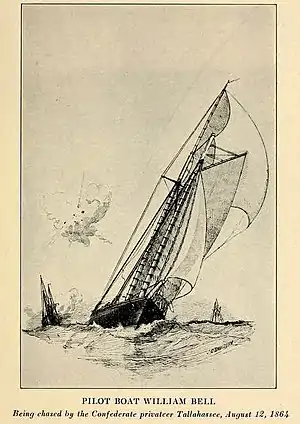 |
Joseph Henderson, William H. Anderson, John Van Dusen, James Callahan | New York pilot-boat William Bell was built in Greenpoint, Brooklyn in 1863–64 by shipbuilder Edward F. Williams of Brooklyn for Joseph Henderson, William H. Anderson, John Van Dusen, and James Callahan. |
Boston Pilot boats
| Ship No. | Ship Name | Image | Ship Captain | Description |
|---|---|---|---|---|
| No. 1 | America | 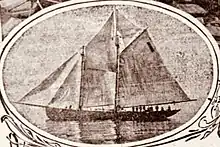 |
James H. Reid Sr. | On 9 March 1897, James H. Reid launched a new pilot boat, America No. 1 from Gloucester, Massachusetts. Pilots James M. Reid, Jr., and Bruce McLean was assigned to the new boat with her owner. On 19 May 1897, the pilot-boat America, No. 1, was built for Captain James H. Reid and designed by Thomas F. McManus. She was launched from the shipyard of John Bishop of Gloucester.[104] The America was registered with the Index to Ship Registers from 1877 to 1900 to James Reid.[41] |
| No. 1 | Lillie | George W. Lawler | Boston pilot-boat Lillie, was design by prominent naval architect Dennison J. Lawlor of Chelsea, Massachusetts, in 1876. Owned by Captain George W. Lawler. Lillie was named after his mother. She was later sold to the New York pilots and renamed the Richard K. Fox.[2][56] The Lillie was registered with the Index to Ship Registers from 1877 to 1892 to George W. Lawler.[41] | |
| No. 1 | Pilot | 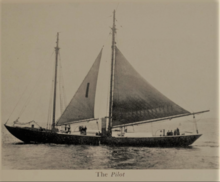 |
William H. Lewis | Pilot-boat Pilot was a replacement for pilot-boat Louise, No. 2, that was withdrawn from service on December 9, 1924. The Pilot was designed by yacht designer William Starling Burgess.[105] She was a spoon-bowed schooner equipped with a twin-screw diesel engine. Her length is 121 ft. and 98 ft at the water line with a 25 ft. beam.[56] |
| No. 2 | Eden D. Jordan | 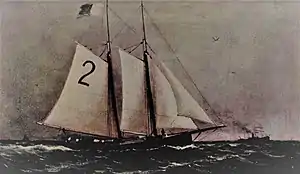 |
Captain Thomas Cooper, Andrew Jackson | The Eden D. Jordan, No. 2, was a 19th Century Boston pilot boat built in 1883, by Ambrose A. Martin in East Boston. Her namesake was Eben Dyer Jordan, the founder of the Jordan Marsh department stores.[106] In 1892, Eben D. Jordan was sold to the New York Harbor pilot group led by George Washington Beebe.[106] In 1893, while on station offshore off Barnegat, New Jersey, she was run down when struck by the SS. Saginaw during a gale.[56] She survived the collision, was salvaged, placed back in service. On 1 February 1896, the New York Pilots discarded sixteen sailboats.[7][41] P.84 In 1906, the Harper was replaced by the Eben D. Jordan.[106]:p28 |
| No. 2 | Louise | 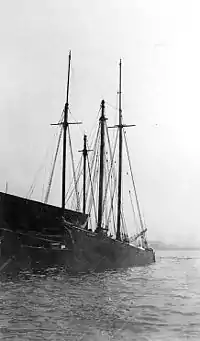 |
Watson S. Dolliver[107] | Boston pilot-boat Louise, was built as a pilot boat in 1900 by Ambrose Martin at East Boston, Massachusetts. The Louise replaced the ill-fated Columbia that washed ashore in 1898.[2] On 10 September 1917 the U.S. Navy acquired her under a free lease from her owner, the Boston Pilots Relief Society, for use as a section patrol boat during World War I.[56] On 9 December 1924, it was reported that the pilot boat Louise, No. 2 would be withdrawn and replaced with the pilot boat Pilot, designed by yacht designer William Starling Burgess.[105] |
| No. 2 | Roseway (replacement for Northern Light) | 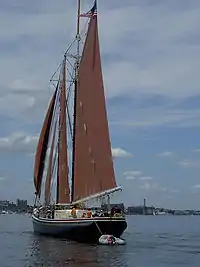 |
World Ocean School | Boston pilot-boat Roseway, was built in 1925 for Harold Hathaway. In 1941, Roseway was purchased by the Boston Pilot's Association to serve as a pilot-boat for Boston Harbor, as a replacement for the pilot-boat Northern Light, No. 3, which was sold to the United States Army for war service.[56][108] Roseway continued to serve as a pilot vessel until the early 1970s, at which point she and San Francisco's Zodiac were the only pilot schooners still in service in the United States. |
| No. 3 | Northern Light (replaced by Roseway) | 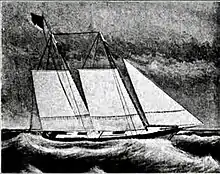 |
William P. Winchester (1st pilot-boat) | The Boston yacht and pilot-boat Northern Light, was owned by Colonel William P. Winchester who was a Boston merchant. Winchester commissioned Louis Winde, an early yacht designer and shipbuilder, to design and build a model for the yacht. She was built in 1839 at the Whitemore & Holbrook shipyard.[109] She went into Boston commission on July 22, 1939.[110]:p389[110] At the end of 1846, she was sold for use as a packet ship. Winchester repurchased her in 1848, then sold her a year later In 1850, she was wrecked in the Strait of Magellan with all hands rescued. In 1927, another boat named the Northern Light was built in Oakland, California, as a yacht for John Borden. Borden took her to the Artic on an expedition for the Field Museum of Chicago.[109]:p32 The Northern Light, was bought by the Boston Pilot's Association to serve as a pilot-boat for Boston Harbor from 1934 to 1941. The Northern Light, was sold to the United States Army in 1941 during World War II. The Roseway was a replacement for the Northern Light when she was sold.[108] |
| No. 3 | Liberty | 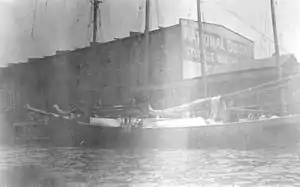 |
J. H. Low | Boston pilot-boat Liberty, was built in 1896 by John Bishop shipyard in Gloucester, Massachusetts. On September 10, 1917 the U.S. Navy acquired her under a free lease from the Boston Pilots Relief Society, for use as a section patrol boat during World War I. She was a 118-ton pilot-boat.[111] |
| No. 3 | D. J. Lawlor |  |
Peter Partridge, Abel F. Hayden (and owner) | Boston pilot-boat D. J. Lawlor, was built in 1882 by Porter Keene at Weymouth, Massachusetts. She was considered the best heavy weather boat in the service. She was named for Dennison J. Lawlor, the prominent pilot boat designer. She was owned in part by Captain William V. Abbott and John Leary. She was rammed and sunk by the fishing boat Horace B. Parker of Gloucester.[56]:p51 |
| No. 4 | Adams | 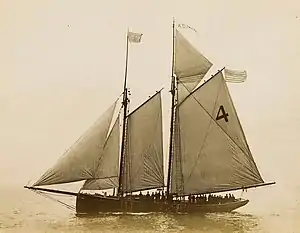 |
John Jeffries | Boston Pilot Boat Adams, was built in 1888 by Moses Adams at Essex, Massachusetts for Captain John H. Jeffery (Jeffries). She was named for the prominent Bostonian, Melvin O. Adams. Her design was by Edward Burgess, America's Cup Defenders, Puritan (1885), Mayflower (1886), and Volunteer (1887). On September 24, 1889, the new pilot boat Adams, was launched witnessed by a large gathering of people.[112] She ended her service in 1901 when she was one of five schooners left. She then landed in the Portuguese immigrant trade. She was sunk by enemy action during World War I.[2]:p134 |
| No. 4 | Edwin Forrest (was replaced by George H. Warren) | .jpg.webp) |
John Jeffries, Henry Harbinson | The Edwin Forrest was designed by Dennison J. Lawlor, for Captain John Low. She was a consistent winner of races in the July 4, Regatta races conducted by Boston.[56]:p82 The Edwin Forrest was launched in Boston from Lawlor's stone-lined slip at Buck's Wharf in Chelsea during 1865.[113] After being in the Boston pilot service for many years, on 8 Aug 1882, the pilot boat Edwin Forrest, No. 4, of Boston, was sold to the Pensacola parties for $5,500.[114] |
| No. 4 | George H. Warren (built to replace Edwin Forrest) | 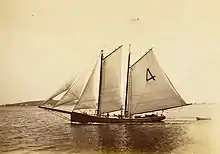 |
William Murphy | Boston pilot-boat George H. Warren, No. 4 was a two-masted schooner-rigged boat of 52-tons. She was built by Porter Keene at Weymouth, Massachusetts, in 1882 to replace the Edwin Forrest, No. 4. She was launched on December 31, 1882 from the N. P. Keen shipyard at North Weymouth.[115] She went on her first cruise on February 14, 1883. She was owned by Captain Jno. Harry Jeffries and others.[116][117] On 7 Jun 1889, the Warren was sold for $9,250 to Captain J. O'Sullivan, and the owners of the pilot-boat Charlotte Webb.[118] On February 7, 1895, Warren went missing just before a great storm. the She had six pilots on board.[119] |
| No. 5 | Hesper |  |
William C. Fowler | Boston pilot-boat Hesper, designed for speed in order to be the first to reach offshore merchant vessels and escort them through the treacherous harbor islands into the port. The fastest boat got to the client first, and Hesper had the reputation of being the fastest throughout her working career. Designed in 1884 by Boston naval architect Dennison J. Lawlor and built by Montgomery & Howard. The schooner measured 102 feet on deck by 23 feet in beam, with a 12-foot draft. She was sold out of the Boston pilot service in 1901[120][56] Other pilots were: George W. Lawler, J. L. Smith, J. A. G. McField, A. Hooper, R. L. Stubbs, R. Y. Woodbury[111] |
| No. 6 | Varuna |  |
Thomas C. Cooper | Boston pilot-boat Varuna, was a 90-ton schooner designed by yacht designer, Edward Burgess and built by Howard & Montgomery in 1890 at Chelsea, Massachusetts. Named for Varuna the Vedic king of the waters of early Hindu mythology.[26] Captain Thomas Cooper transferred to the pilot-boat Varuna, No. 6, when the Columbia was washed ashore in the Portland Gale of 1898, Cooper had ownership in the Varuna. She was also in the Bortland Storm but was able to board a larger vessel inbound from Philadelphia. They were able to tow the pilot-boat into the harbour.[2] |
| No. 6 | Florence |  |
William C. Fowler, James H. Reid | Boston pilot-boat Florence, was a 19th-century boat built in 1867 from a model by Dennison J. Lawlor. The vessel had a reputation for being fast under sail. She had a long career in the Boston service, skippered by many famous pilots. She was the oldest pilot-boat in the service.[56] From 1879 to 1889, the Boston pilot-boat Florence, had the number 6 painted on her mainsail and William C. Fowler was the master. By 1893, the number on her mainsail change to No. 1, with James H. Reid as the captain. |
| No. 7 | Minerva | 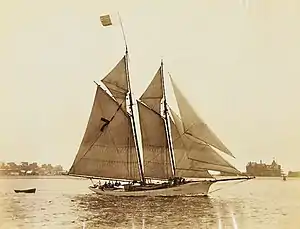 |
Franklin B. Wellock, F. Fowler, S. F. Wellock, H. Folger[111] | Boston pilot-boat Minerva No. 7, was built in East Boston, Massachusetts in 1896. She was designed and built by Ambrose A. Martin, who built the Columbia, Eben D. Jordan, and Friend. She took a trial trip on 14 March 1896 from the National dock at East Boston. Captain Franklin B. Wellock was in command of her. On her way of Boston Harbor she sailed past Fort Warren, Fort Winthrop and then the Brewsters.[121] |
| No. 7 | Friend (replaced by pilot-boat Columbia) (Friend is listed as New Jersey pilot-boat in 1895)[13]:p380 | 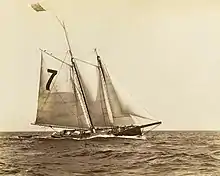 |
Thomas Cooper (1893), Joe Fossett, John Ashcraft (1895) |
Boston pilot boat Friend No. 7 was built in 1848 by Kelley & Holmes East Boston shipyard. She was 65-tons.[122] On November 15, 1887, a new pilot-boat Friend, was launched from the Lawler's shipyard on Condor Street.East Boston, The Boston Globe. On 21 October 1893, Captain Thomas Cooper, sold the Friend to the New York Pilots.[123] when she was 40 years old. In 1894, the pilot-boat Friend was replaced by the pilot-boat Columbia, built by Ambrose D. Martin at East Boston for Thomas Cooper.[2]:p163 |
| No. 8 | Columbia (replaced by Louise No. 2) | _(14781858532).jpg.webp) |
Augustus Van Pelt | Boston pilot-boat Columbia, No. 8, was built and launched on 15 November 1878 by C. & R. Poillon shipyard at the foot of Bridge Street. The boat was built for the pilots that owned the Isaac Webb, which was lost off Point Judith in July 1879.[124] Columbia, was run down off Fire Island on 3 December 1883, by the steamer S. S. Alaska of the Guion Line.[125] A second, Columbia, No. 8, of the East Boston yard of Ambrose A. Martin for Captain Thomas Cooper in 1894 to replace the pilot-boat Friend.[2] The Columbia was driven ashore at Sand Hills Scituate, Massachusetts in the great "Portland" storm on 26 November 1898, with the loss of all five men aboard.[126] The Louise No. 2 replaced the ill-fated Columbia. Designed by William Townsend.[37] |
| No. 8 | Sylph | 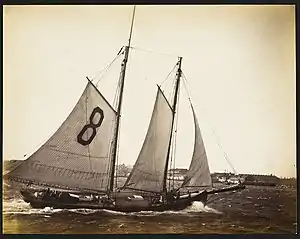 |
J. W. Colby, T. J. Gevalt, F. C. Gevalt,[111] David Kendrick | Boston pilot-boat Sylph was built at North Weymouth, MA in 1878. She was sold out of service in 1901, after 23 years of Boston pilot service.[127][56] There was an earlier sixty-foot pilot boat Sylph owned by Robert Bennet Forbes. Built in Boston in 1834 by Whitmore & Holbrook for John Perkins Cushing. As a yacht in 1835, she won the first recorded American yacht race on 3 August 1835. She was a pilot boat in Boston Harbor in 1836 and 1837 and sold to the Sandy Hook Pilots in October 1837. She was lost in winter of 1851 with all hands during a blizzard off Barnegat, New Jersey.[56] |
| (No Sail Boat Number) | Daniel Webster | 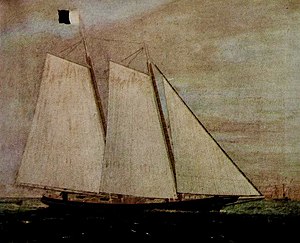 |
William R. Lampee as a pilot and Thomas Cooper | Boston pilot-boat Daniel Webster was built at Chelsea, Massachusetts, in 1851. She left for San Francisco when she sailed for Shanghai, China, in 1865 to become a pilot boat in 1886. The Daniel Webster operated until 1892 when she was lost in a storm. All pilots were rescued.[56]:p56 After loosing the Dancing Feather, in 1854, the Daniel Webster, was purchased in 1854.[2] |
| (No Sail Boat Number) | Caleb Curtis | (no picture) | unknown | The Boston pilot-boat Caleb Curtis, was built in 1859. She was 80-tons and well known for her speed. She served two years before sailing from Boston around Cape Horn and then to San Francisco. She was wrecked inside the Bonita Channel on 11 April 1867. She was towed into San Francisco, repaired, and was able to continue, not as a pilot-boat but in commercial trade. The 1867 Boston built pilot-boat Geroge F. Peabody, replaced th lost Caleb Curtis.[2]:pp210–211[128] |
| (No Sail Boat Number) | Dancing Feather | (no picture) | James L. Fowler | The pilot-boat Dancing Feather, was built in 1853, from a model by the noted Boston builder and designer, Dennison J. Lawlor, at the Lawlor shipyard of East Boston, in Boston, Massachusetts. She was a schooner-rigged vessel with a sharp bow and round stern.[129] She went to San Francisco in 1854 with Captain James L. Fowler, his son Franklin Fowler, and pilot Warren Simpson.[56]:p35 In December 1854, she went to the wreck of the three-masted steamship SS Yankee Blade and was able to raise four boxes of treasure from the sunken vessel, which amounted to $70,000.[130] She went ashore on the beach north of Point Bonita in May 1857.[2]:p210 |
New Jersey Pilot boats
| Ship No. | Ship Name | Image | Ship Captain | Description |
|---|---|---|---|---|
| No. 1 | Moses H. Grinnell | 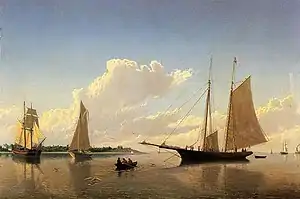 |
H. L. Gurney, J. B. Lockman[26] Thomas Morley (1860), Frank Wheelock |
New Jersey pilot-boat Moses H. Grinnell was built in 1850 for the Jersey pilots and designed by George Steers. She was owned by George W. Blunt. She was the first pilot boat to show the fully developed long entry that was to become the New York schooner's trade mark.[2] The pilot boat was one of twenty-one New York pilot boats in 1860.[131] She was run down by the United States supply steamer Union on the Outer Middle Ground in October 1863.[19] On October 24, 1882, the Grinnell, was sold to the Pensacola, Florida pilots for $4,500. This was the third pilot-boat that was purchased from the Boston pilots.[132] |
| No. 1 | Thomas S. Negus | 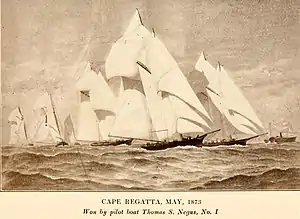 |
Joseph McClurek, William Lewis[26] |
New Jersey Pilot-boat Thomas S. Negus, No. 1 was built by the C. & R. Poillon shipyard in Brooklyn.[2] On 9 October 1873, the Thomas S. Negus was one of winners in the Ocean Yacht Race Regatta, which was a race from Owl's Head Point around to Cape May Lighthouse in New Jersey, and back to the Sandy hook Lightship. The race was sponsored by Joseph F. Loubat who was a yachtsman, who offered a prize of $1,000 for the race.[13][1] The Thomas S. Negus was registered with the Index to Ship Registers from 1876 to 1900 to Captain William Lewis.[41] |
| No. 2 (No. 11 when sold to New York pilots) | Ezra Nye | 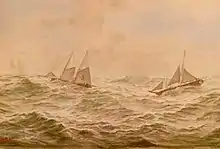 |
Benjamin J. Guinness | The pilot-schooner Ezra Nye was launched on 8 March 1859 from Wells & Webb shipyard in Greenpoint, Brooklyn.[133] She was registered with the Record of American and Foreign Shipping, 1876 to 1885. Benjamin J. Guinness was the ship master.[41] On March 12, 1888, in the Great Blizzard of 1888, the New Jersey pilot-boat Ezra Nye, along with other pilot-bats, was caught up in one of the most severe blizzards in American history. She was salvaged and sold to the New York Sandy Hook Pilots.[134] On 1 February 1896, the New York Pilots discarded sixteen sailboats and replaced with steam pilot boats.[7] |
| No. 2 | Elbridge T. Gerry | unknown | unknown | New Jersey pilot-boat Elbridge T. Gerry listed in 1895. (TBD).[13]:p380 |
| No. 3 | Thomas D. Harrison | unknown | unknown | New Jersey pilot-boat Thomas D. Harrison listed in 1895. (TBD.)[13]:p380 |
| No. 3 | Commerce | McNight Smith | New Jersey Pilot Boat Commerce from Norfolk, belonged to the New Jersey and Sandy Hook Pilots in 1840.[135] On 7 February 1845, the Commerce, while on pilot duty, went ashore near Elm Tree, and bilged.[136] On 24 January 1853, the pilot boat Commerce was reported lost on the New Jersey coast in a gale, having on board four pilots: McKnight Smith, Mathew M. Betts, Thomas Scott, and Nelson Cole; one apprentice Thomas Smith (son of McKnight Smith), and a crew of five hands: Roger Clark, boatkeeper; a cook; and three men. The pilot-boat Nettle was the last boat to see her off Egg Harbor, New Jersey.[137] | |
| No. 4 | Mary E. Fish (replaced Mary Taylor, No. 5) | (no picture) | Richard Brown (pilot) | New Jersey pilot-boat Mary E. Fish, No. 4, was built from the shipyard of Mr. E. F. Williams of Greenpoint, Brooklyn.[138] On 9 October 1873, the Mary E. Fish was one of the boats that participated in the Ocean Regatta, which was a race from Owl's Head Point around to Cape May Lighthouse in New Jersey, and back to the Sandy hook Lightship.[1] Brown was also the captain and part owner of the pilot boat Mary E. Fish. He helped supervise the construction of the Fish and served aboard her from 1876 to 1885.[139] Mary E. Fish, was built to replace the Mary Taylor, which was lost by a three-masted schooner near Barnegat, New Jersey.[19]:p23 |
| No. 4 | Trenton | 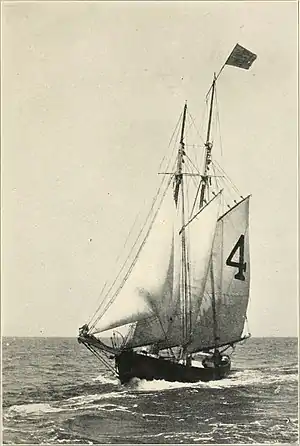 |
Charles Beebe | New York pilot-boat Trenton, No. 4, was an auxiliary motor pilot boat purchased for pilot service in 1907. She was formerly the fishing schooner Kernwood.[19]:p93 Captain Thompson was captain of the schooner Kernwood, that went out on her maiden voyage in 1904. The Kernwood was designed by Thomas F. McManus of Boston and was built in Essex County, Massachusetts.[140] Captain Charles Beebe was assigned to the pilot boat Trenton, and sailed to Long Branch, New Jersey on 10 October 1910, looking for incoming steamers. Captain Walter Earl, of East Orange, New Jersey was one of the pilots.[141] |
| No. 7 | Centennial | 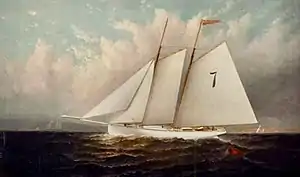 |
John Hopkins (1877-1879) | New Jersey pilot-boat Centennial, was modeled and design by prominent naval architect Dennison J. Lawlor of Chelsea, Massachusetts, on February 22, 1876. On June 24, 1876, the trail trip of the Pilot Boat Centennial, was witnessed by a party of gentlemen. The tug boat J. C. Neattie, towed her down the Boston harbor and passed the Narrow. Captain Francis C. Cates, took the helm. Robert Crosbie of East Boston, the builder, was on board. The pilot-boat Lillie, was sited and a race began. The course of nine miles was from Boston Light to Minot's Ledge. She is 77 feet in overall length, 29.10 feet beam, 8.4 feet hold, and 82 tons. The boat was owned by Beebe & Hopkins of New York.[142] New Jersey pilot-boat Centennial was listed in 1895. (TBD.)[13]:p380 |
| No. 7 | James W. Elwell | (no picture) | Chas. E. Warner | The pilot-boat James W. Elwell No. 7, was built in 1867, for the New Jersey and Sandy Hook pilots, at Mystic Bridge, New London, Connecticut, by John A. Forsyth, who built the yacht L' Hirondelle, which was owned by S. Dexter Bradford. She On 2 April 1867, she went on a trial trip from New York City with a large party of guests past Sandy Hook, as far as the Highlands. She was a fast boat, her average speed was 15 knots per hour. The dishes and glasses were had her name on it. Francis Perkins, No. 13 was seen on the return and the two boats raced back to the city. Charles E. Warner was Master of the boat.[143] The James W. Elwell was registered with Record of American and Foreign Shipping, from 1871 to 1876. She was owned by the Pilots' Association. She was 74-tons, 90 feet length, 22.6 inches breadth of beam, 8.4 inches depth of hold. Charles E. Warner was the ship Master.[144] On 9 October 1873, the James W. Elwell was one of the boats that participated in the Ocean Regatta, which was a race from Owl's Head Point around to Cape May Lighthouse in New Jersey, and back to the Sandy hook Lightship. The Elwell came in third place. The Enchantress won first place, and the pilot-boat[[Thomas S. Negus]] second place.[1] On 13 November 1875, the pilot-boat James W. Elwell, No. 7, went ashore on North Beach Haven, New Jersey was abandoned.[145] |
| No. 8 | Edward E. Barrett | 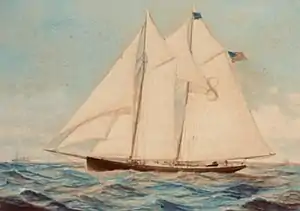 |
Captain W. W. Black | New Jersey pilot-boat Edward D. Bartlett, No. 8 was launched on 1 November 1883 from the C. & R. Poillon shipyard. She was dsigned by William Townsend, who designed the pilot-boats Columbia, James Gordon Bennett.[146] She was christened the Edward D. Bartlett by Amelia Eva Bartlett, the daughter of Edward D. Bartlett, whom the boat was named.[147] During the Great Blizzard of 1888, the Edward E. Barrett, No. 8, along with other pilot boats, took cover at a house near the Sandy Hook Lighthouse.[148] In 1904, she was put up for sale for $3,000.[149] |
Not identified with sail boat number
| Ship Name | Image | Description |
|---|---|---|
| Jabez Williams | (no picture) | New York Sandy Hook pilot boat Jabez Williams was launched 1 March 1850 and owned by the Association of Pilots. She was 90-tons burden, 64 feet long, 19.5 beam, and 7.5 hold. She was launched from the Jabez Williams & Company shipyard. J. Williams & Co., New York Tribune, May 1850 |
| Whilldin |  |
The pilot-boat Whilldin off Cape May New Jersey. Humphrey Hughes was the pilot when it was capsized.[150] The pilot boats Whildin and Cope worked off the Delaware capes. The Deleware pilots had only the Cope and the Bayard, while the Pennsylvania and New Jersey competitors have the Whildin, C. K. Knight, Howard, Christian Bergh, and Turley.[151] |
| New York | 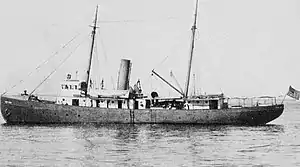 |
The New York was the first steam pilot-boat in the New York harbor. She was built in 1897, for the Sandy Hook Pilots' Association by the Harlan and Hollingsworth Company at Wilmington, Delaware. She was designed by Archibald Cary Smith.[152] She was launched on March 18, 1897, at the Harlan & Hollingsworth Company, with a large number of New York and New Jersey pilots and their families in attendance.[153] She was sponsored by Marie Morse, daughter of the President of the Harlan & Hollingsworth Company.[19]:p86 James E. McCarthy, Jr., was a pilot on the pilot-boat New York.[154] On 19 Mar 1898, the pilot Commissioners decided to place the New York into the Government auxiliary war fleet. She was priced at $185,000.[155] |
| New Jersey | 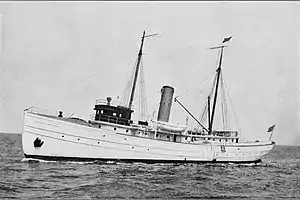 |
Steam pilot-boat New Jersey was built by A. C. Brown & Sons of Tottenville, Staten Island, in 1902. She was sank off Ambrose Lightship, on July 10, 1914 by the S.S. Manchioneal, after only twelve years of service.[19]:p89 The New Jersey was replaced by the pilot boat Sandy Hook. |
| Sandy Hook | 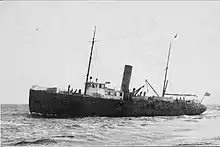 |
Steam pilot-boat Sandy Hook was formerly the steam yacht Privateer. She was purchased from R. A. C. Smith for to replace the New Jersey. She was built in 1902, by Lewis Nixon at the Crescent Shipyard in Elizabeth, New Jersey. Her dimensions were 168.6 ft. in length; 24.4 ft. breadth of beam; 12.6 ft in depth; and 361-tons. She was built with an 1,000-horse power engine.[19]:p90 |
See also
References
- Loubat, Joseph Florimond (1887). A yachtsman's scrap book: or, The ups and downs of yacht racing. New York, Brentano Brothers.
- Cunliffe, Tom (2001). Pilots, The World Of Pilotage Under Sail and Oar. Brooklin, Maine: WoodenBoat. p. 73. ISBN 9780937822692.
- New Pilot Boat, Herman Oelrichs, Proves to be a Flyer.
- Pilot Boat Oelrich Sold.
- "Launch". Brooklyn Evening Star. Brooklyn, New York. 11 August 1858. p. 3. Retrieved 11 August 2020.
- "Launched". The Brooklyn Daily Eagle. Brooklyn, New York. 20 August 1858. p. 3. Retrieved 11 August 2020.
- "Not Up To Date. Why New York Pilots Are Discarding Sailboats". The Standard Union. Brooklyn, New York. 1 February 1896. p. 7. Retrieved 8 September 2020.
- "Launch". The New York Herald. 12 August 1875. p. 10. Retrieved 5 October 2020.
- "Pilotboat Knight Safe". The Morning News. Wilmington, Delaware. 13 February 1895. Retrieved 17 August 2020.
- Local and General News Of Ships and Shipping.
- NEW PILOT BOAT, New York Times, June 20, 1860, Page 8
- EXCURSION ON A PILOT-BOAT., New York Times, July 9, 1860, Page 8
- Russell, Charles Edward (1929). From Sandy Hook to 62°. New York: Century Co. OCLC 3804485.
- Notes on the Stowage of Ships By Charles H. Hillcoat, 1919, Publisher is Colonial Pub.
- 1876 Mystic Record
- "Arrival of the Great Eastern". 28 June 1860. Retrieved 2 August 2020.
- The Sun, New York, New York, 02 Aug 1884, Page 1.
- "The American Yacht List: Containing a Complete Register of the Yacht Clubs, List of Pilot Boats, Port of New York". L. H. Biglow & Co. Printers And Stationers, 13 William Street. New York. 1874. Retrieved 1 September 2020.
- Allen, Edward L. (1922). Pilot Lore From sail to Steam. New York: The United New York and New Jersey Sandy Hook Pilots Benevolent Associations.
- "Disasters". Boston Post. Boston, Massachusetts. 3 February 1879. p. 4.
- "The New Pilot Boat Alexander M. Lawrence for Admiral Murphy and His Partners". Times Union. Brooklyn, New York. 21 May 1879. Retrieved 7 September 2020.
- "Famous Pilot Boat Sold". The Morning Call. Allentown, Pennsylvania. 17 August 1897. Retrieved 18 August 2020.
- "A New Pilot Schooner". The New York City Herald. New York New York. 22 January 1840. p. 2. Retrieved 9 January 2021.
- "A Pilot's Perils". The Marion Times-Standard. Marion, Alabama. 23 April 1890. p. 6. Retrieved 7 September 2020.
- "Memoranda". The Baltimore Sun. Baltimore, Maryland. 5 October 1846. p. 2. Retrieved 6 January 2021 – via Newspapers.com.
- "The American Yacht List: Containing a Complete Register of the Yacht Clubs, List of Pilot Boats, Port of New York". 1874. Retrieved 1 September 2020.
- Mystic Record
- "Webb & Bell's Shipyard". Brooklyn Union. Brooklyn, New York. 25 May 1865. p. 1. Retrieved 21 November 2020 – via Newspapers.com.
- "Two Collisions in a Fog". Democrat and Chronicle. Rochester, New York. 20 May 1889. p. 1. Retrieved 21 November 2020 – via Newspapers.com.
- "A Model Pilot Boat The Successful Launching of the David T. Leahy". The New York Times. 4 September 1890. ProQuest 94789799.
- Pilot Boat David T. Leahy. She Departed on Her Perilous Journey Yesterday
- Pilot Reardon's Side. Of the Collision with Royal Phelps Carroll's Yacht, Brooklyn Daily Eagle (Brooklyn, New York) 16 Jun 1893, Page 1
- New York Daily Herald New York, New York, 16 Dec 1840, Page 2
- Later News At Hand. The Charleston Daily Courier (Charleston, South Carolina), 28 Dec 1837, Page 2
- "Something like a Pirate ". Hartford Courant. Hartford, Connecticut. 27 August 1839. p. 2. Retrieved 15 January 2021 – via Newspapers.com.
- "Reprduced slave ship will house black history exhibit ". Hartford Courant. Hartford, Connecticut. 13 March 1995. p. 9. Retrieved 15 January 2021 – via Newspapers.com.
- Successful Launch of a New Pilot Boat This Morning.
- "Pilot Boat Run Down, Four Men Are Drowned". The Brooklyn Daily Eagle. Brooklyn, New York. 18 August 1901. p. 1. Retrieved 24 December 2020 – via Newspapers.com.
- "LAUNCH OF A PILOT-BOAT". The New York Times. New York, New York. 11 October 1865. p. 8. Retrieved 6 November 2020.
- "The New Pilot Boat". The New York Herald. New York, New York. 12 May 1870. p. 2. Retrieved 24 December 2020 – via Newspapers.com.
- "Index to Ship Registers". research.mysticseaport.org. Mystic seaport. Retrieved 13 December 2020.
- "Five Men Lost, The Sad Fate of the Pilot Boat W. H. Starbuck". The Brooklyn Daily Eagle. Brooklyn, New York. 15 March 1888. Retrieved 11 August 2020.
- A Fish Story. New England Farmer (Boston, Massachusetts), 24 Jul 1824, Page 8
- The Losss of the Pilot Boat Thomas H. Smith
- "French Man-Of-War Here". The Evening World. New York, New York. 27 July 1894. Retrieved 11 August 2020.
- Vessel Cut In Halves. Pilot Boat Sunk by Big Liner. Crew's Miraculous Escape. The Pittsburgh Press (Pittsburgh, Pennsylvania), 16 Dec 1906, Page 13
- Long, Low, Black Schooner. The Sunbury Gazette (Sunbury, Pennsylvania), 07 Sep 1839, Page 2
- Cahpelle, Howard I. (1960). The National Watercraft Collection. United States National Museum, Bulletin 219. p. 89.
- Suburban Notes.
- Arrived New York Daily Herald (New York, New York), 24 Apr 1838, Page 3
- Memoranda The Evening Post (New York, New York) 30 Jun 1838, page 3
- British Brig Sisters.
- Disasters.
- Figure-Head Picked Up At Sea.
- "Launch Of The Pilot Boat James Avery". York Daily Herald. New York, New York. 9 September 1837. p. 2. Retrieved 25 January 2021.
- Eastman, Ralph M. (1956). Pilots and pilot boats of Boston Harbor. Boston, Massachusetts: Second Bank-State Street Trust Company.
- "Local Summary". Boston Post. Boston, Massachusetts. 29 August 1872. Retrieved 4 October 2020.
- The Brooklyn Daily Eagle, Brooklyn, New York, 25 Oct 1902, Page 7
- "Yachting Notes". New York Herald. New York, New York. 30 April 1871. p. 7. Retrieved 8 December 2020.
- Correspondence of the Herald. New York Daily Herald (New York, New York), 20 Dec 1844, Page 3
- Particulars Of The Storm New York Daily Herald (New York, New York), 6 Feb 1845, Page 2
- Melanchology Brooklyn Evening Star (Brooklyn, New York), 1 Feb 1848, Page 2
- Marine Disasters. The effects of the Late Snow Storm and Intense Cold. New York Daily Herald, New York, New York, 14 Jan 1856, Page 1
- Wreck of the Pilot Boat E. K. Collins The Buffalo Daily Republic, Buffalo, New York, 19 Jan 1856, Page 2
- "Miscellaneous". New York Herald. 2 December 1861. p. 8. Retrieved 5 September 2020.
- History, Naval; Command, Heritage (9 July 2015). "G. W. Blunt". Dictionary of American Naval Fighting Ships. Naval History And Heritage Command. Retrieved 5 September 2020.
- "Two Barks, one Brig, two Schooners and a Pilot Boat Ashore on Jersey Coast". New York Daily Herald. New York, New York. 15 January 1856. Retrieved 12 September 2020.
- "Hit by a Falling Mast. Pilot Handran Killed On The Commodore Bateman". Times Union. Brooklyn, New York. Retrieved 3 August 2020.
- "Sale of the Pilot-Boat Romer". The New York Times. New York, New York. 12 March 1860. Retrieved 18 August 2020.
- Launch The Brooklyn Union (Brooklyn, New York) 22 Nov 1864, age 3.
- Mystic
- A Pilot-Boat Lost. Sunk In A Collision With A Steam-Ship And One Man Drowned. The New York Times (New York, New York) 6 Mar 1883, Page 8
- Totenville New-York Tribune (New York, New York)26 May 1883, Page 8
- Pilot Boat Rammed and Sunk The Sun, New York, New York, 24 May 1912, Page 1.
- "Pilot Boat Number Thirteeen". The Standard Union. Brooklyn, New York. 13 September 1887. p. 2. Retrieved 8 September 2020.
- "On the Story". Harper's Weekly. Vol. 54. 2 July 1910. Retrieved 28 November 2020.
- Marine Intelligence The New York Times, 28 August 1863
- "The New York Pilots. To The Editor Of The Herald". New York Daily Herald. New York, New York. 10 October 1860. p. 2. Retrieved 28 January 2021.
- General Telegraph News Hudson Register, 24 January 1887
- "The Lost Pilot Boat", upload.wikimedia.org, retrieved 2 August 2020
- Reddin Buried. The Body of the Brooklyn Pilot Found.
- Launched
- New York Daily Herald, New York, New York, 2 April 1855, Page 8
- "Collided With A Whale. The Experience of the Pilot Boat Acaea Off Sandy Hook". St. Louis Post-Dispatch. St. Louis, Missouri. 13 June 1891. Retrieved 18 August 2020.
- "Disaster At Sea, A New York Pilot Boat Cut Down by an Ocean Steamer". New York Evening Express. 30 March 1871.
- Launch
- "Collision In The Bay. The Steamship New Orleans Sinks The Sandy Hook Pilot Boat Caprice". New York Daily Herald. New York, New York. 28 February 1876. Retrieved 18 August 2020.
- New York Pilots
- Pilot Boat Race. New York Daily Herald, New York, New York 03 Apr 1855, TuePage 10
- "A Pilot Boat Adrift Empty. Collision of the Enchantress with a Schooner, Crew and Pilots Saved". 1 April 1884. Retrieved 12 August 2020.
- Miscellaneous New York Daily Herald, New York, New York, 28 Jan 1861, page 3
- "The Pilot-bat Westervelt Run Down By A Steamship-One of the Pilots Drowned". New-York Tribune. New York, New York. 21 April 1858. Retrieved 1 September 2020.
- Loss of the Pilot Boat Jacob A. Westervelt (No. 19) 5 August 2010
- Pilot Boat For Sale New York Daily herald, New York, New York, July 27, 1845, Page 3
- "Index to Ship Registers". research.mysticseaport.org. Mystic seaport. Retrieved 4 January 2021.
- Russell, Charles Edward (1929). From Sandy Hook to 62°. New York: Century Co. pp. 159, 267, 387. OCLC 3804485.
- Miscellaneous.
- Long Island, The Pilot Boat W. H. Aspinwall, No. 21.
- "Annual Meeting of the Commissioners-A Year of Prosperity". The New York Times. New York, New York. 5 January 1881. Retrieved 24 August 2020.
- Record of American and Foreign Shipping 1890 Walter Brewer was ship master.
- "Launch". The New York Times. New York, New York. 28 December 1859. p. 8. Retrieved 10 January 2021 – via Newspapers.com.
- Sinking of One Pilot Boat and Serious Damage to Another
- Accident To The Schooner Wanata The Charleston Daily News (Charleston, South Carolina) 11 Mar 1869, Page 3
- "the Pilot Boat America No. 1 given a "Limbering Up" Today". The Boston Globe. Boston, Massachusetts. 27 February 1898. Retrieved 24 August 2020.
- "New Pilot Boat Greeted By Steam Craft On Trial Trip Down Harbor". The Boston Globe. Boston, Massachusetts. 9 December 1924. Retrieved 6 September 2020.
- Pilot Schooner ALABAMA
- Escaped Prisoners On Frail Raft Rescued In Nick Of Time.
- "Roseway (Schooner) - NPGallery - National Park Service". United States Department of the Interior, National Park Service. p. 10. Retrieved 17 December 2020.
- Eastman, Ralph M. (1956). Pilots and pilot boats of Boston Harbor. Boston, Massachusetts: Second Bank-State Street Trust Company. p. 30.
- Thompson, Winfield M. (1903). "The Rudder; Historic American Yachts Early Boston Vessels, The Northern Light and Coquette" (PDF). Boston.
- Boston's Pilot System.
- "Boston's New Pilot Boat. The Adams, a Marvel of Beauty and Strength, Slid from the Ways at Essex". The Boston Globe. 15 January 1900. Retrieved 11 November 2020.
- Dunne, W. M. P.; Patrick, William Matthew (1934). Thomas F. McManus and the American fishing schooners: an Irish-American success story. Mystic, Conn., Mystic Seaport Museum.
- Pensacola Buys a Boat The Montgomery Advertiser, Montgomery, Alabama, 8 Aug 1882, Page 1
- A New Pilot-Boat Launched. New-York Tribune, New York, New York, 01 Jan 1883, Page 1
- A New Pilot Boat The Boston Globe, Boston, Massachusetts, 16 Feb 1883, Page 4
- Record of American and Foreign Shipping 1884.
- Pilot Boat George H. Warren, No. 4, Gets a New Owner The Boston Globe, Boston, Massachusetts, 07 Jun 1889, Page 6
- "Pilot Boat Missing". Star-Gazette. Elmira, New York. 28 February 1895. p. 1. Retrieved 15 December 2020.
- Half Model of the Pilot Schooner Hesper
- "New Pilot Boat Minerva. First Time Under Sail". The Boston Globe. Boston, Massachusetts. 15 March 1896. p. 6. Retrieved 31 October 2020 – via Newspapers.com.
- "Ship Building at East Boston". The Vermont Union Whig. Rutland, Vermont. 6 January 1848. p. 2. Retrieved 25 December 2020 – via Newspapers.com.
- "Boston Pilot Boat Sold". The Boston Globe. Boston, Massachusetts. 23 October 1893. p. 4. Retrieved 18 October 2020.
- "The New Pilot Boat Columbia, No. 8. A Description of the Vessel, The Event Witnessed by a Large Assemblage". The Brooklyn Daily Eagle. Brooklyn, New York. 15 November 1879. Retrieved 14 September 2020.
- "Lost Hope Regarding Pilot Boat No. 8, of the New York Fleet". The Brooklyn Daily Eagle. Brooklyn, New York. 5 December 1883. Retrieved 4 August 2020.
- "Battleship Massachusetts Goes to New York". newspapers.com. Retrieved 2 August 2020.
- Pilot schooner Sylph No. 8
- "From California". New England Farmer. Boston, Massachusetts. 20 April 1867. p. 2. Retrieved 21 December 2020 – via Newspapers.com.
- Chapelle, Howard I. (1960). "The National Watercraft Collection". United States National Museum, Bulletin 219. Washington, D.C.: Smithsonian Institution. p. 90.
- "Interesting News From California". The Washington Sentinel. Washington, District of Columbia. 28 December 1854. p. 2. Retrieved 18 December 2020 – via Newspapers.com.
- Russell, Charles Edward (1929). From Sandy Hook to 62°. New York: Century Co. OCLC 3804485.
- "Marine Notes". The Boston Globe. Boston, Massachusetts. 24 October 1882. p. 4. Retrieved 1 October 2020.
- "News Items". Brooklyn Evening Star. Brooklyn, New York. 8 March 1859. p. 3. Retrieved 2 November 2020 – via Newspapers.com.
- "Schooner Ezra Nye". The Brooklyn Daily Eagle. Brooklyn, New York. 22 October 1833. p. 50. Retrieved 7 January 2021 – via Newspapers.com.
- Memoranda, The Evening Post (New York, New York) 15 Jan 1840, Page 3
- Icidents of the Storm The Brooklyn Daily Eagle (Brooklyn, New York), 07 Feb 1845, Page 2
- "The Missing Pilot Boat Commerce". Retrieved 2 August 2020 – via newspapers.com..
- "the Pilot Yachts". Brooklyn Evening Star. Brooklyn, New York. 13 September 1862. Retrieved 17 August 2020.
- Shaw, David W. (2004). America's Victory: The Heroic Story of a Team of Ordinary Americans. ISBN 9781574091878. Retrieved 2 August 2020.
- Dunne, W. M. P.; Patrick, William Matthew (1934). Thomas F. McManus and the American fishing schooners: an Irish-American success story. Mystic, Conn., Mystic Seaport Museum. p. 229.
- Pilots Land Here. Captain Charles Beebe and East Orange Friend Anchor Offshore. The Daily Record, Long Branch, New Jersey, 27 Oct 1910, Page 3
- A Pleasant Sail. Trial Trip of the New Pilot Boat Centennial. The Boston Globe, Boston, Massachusetts, 26 Jun 1876, Page 5
- Trial Trip Of The Pilot Boat James W. Elwell, No. 7 New-York Tribune, New York, New York, 03 Apr 1867, Page 8
- "Record of American and Foreign Shipping 1884". Mystic Seaport Museum. New York. Retrieved 6 January 2021.
- Pilot Boat James W. Elwell Abandoned. The New York Times (New York, New York)14 Nov 1875, page 1
- "Successful Launch of a New Pilot Boat This Morning". Brooklyn Daily Eagle. Brooklyn, New York. 1 November 1883. Retrieved 14 September 2020.
- Edward D. Bartlett; Successful Launch of a New Pilot Boat This Morning
- Russell, Charles Edward (1929). From Sandy Hook to 62°. New York: Century Co. p. 361. OCLC 3804485.
- For Sale-Boat. The Brooklyn Daily Eagle, Brooklyn, New York, 15 Jul 1904, Page 12.
- "Letter From Cap May. McMakin's Atlantic Hotel, Cape May City, Nov. 29, 1870". Reading Times. Reading, Pennsylvania. 2 December 1870. Retrieved 17 August 2020.
- "River Notes". The Morning News. Wilmington, Delaware. 30 March 1886. p. 4. Retrieved 17 August 2020.
- "Steam's Long War. Last Of The Famous Sandy Hook Pilot Boats Abandoned". The Buffalo Times. Buffalo, New York. 13 June 1897. Retrieved 3 December 2020.
- "First Steam Pilot Boat. It Will Shortly Be Placed on the Sandy Hook Station". The Brooklyn Daily Eagle. Brooklyn, New York. 11 July 1897. p. 9. Retrieved 23 December 2020.
- Obituary, James E. McCarthy Jr.
- The New York Times (New York, New York)19 Mar 1898, SatPage 2
External links
- The Sandy Hook Pilots website
- Digital Commonwealth Pilot Boats website
This article is issued from Wikipedia. The text is licensed under Creative Commons - Attribution - Sharealike. Additional terms may apply for the media files.